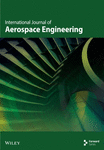Design of Reinforcement Learning Guidance Law for Antitorpedo Torpedoes
Abstract
Guidance law design is a critical technology that directly influences the interception performance of antitorpedo torpedoes. In response to the performance degradation of classic proportional guidance laws and derivative guidance laws when intercepting high-speed underwater targets and the significant impact of the proportional coefficient on interception miss distance, this paper proposes an intelligent guidance law. Based on the proportional guidance interception law, the law incorporates a variable proportional coefficient based on the deep Q-network (DQN) algorithm from deep reinforcement learning. Integrating engineering design, the intelligent guidance law for antitorpedo torpedoes proposed in this article selects the rate of change in the line-of-sight angle as the state variable, designs a reward function based on interception results, and designs a discretized behavior space based on the commonly used proportional guidance coefficient selection range. The greedy algorithm and temporal difference learning are employed to train the DQN, and the optimal proportional guidance coefficient is selected from the DQN by the real-time state of the torpedo. The feasibility of the proposed guidance law was verified through simulation experiments. The interception effects of the proposed intelligent guidance law and the fixed coefficient proportional guidance law were compared and analyzed in typical situations. The results demonstrated that the reinforcement learning guidance law was significantly superior to the traditional proportional guidance law in terms of miss distance, maneuvering ability consumption, and ballistic straightness and had stronger robustness. Furthermore, the intelligent guidance law for antitorpedo torpedoes proposed in this article enables antitorpedo torpedoes to make autonomous decisions based on the battlefield situation.
1. Introduction
With the continuous improvement of torpedo against resistance and intelligence levels, ship platforms are equipped with various detection and maneuvering capabilities, forcing surface ships to use more ways to defend against it [1]. Currently, surface ships use acoustic decoys, acoustic jammers, and other “soft confrontation” equipment. However, their effectiveness in deception is gradually diminishing, creating an urgent need for reliable active defense solutions. In this context, antitorpedo torpedo (ATT) technology has become one of the key areas of research and development for naval forces worldwide. ATT, as a kind of active “hard kill” defense weapon, has the characteristics of active, flexible, high maneuverability, etc. Due to its high probability of intercepting and destroying torpedoes, ATT plays a crucial role in enhancing the survivability of surface vessels and submarines. Therefore, the study of control and interception methods for ATT is of significant importance. Different from the traditional torpedo, the target of ATT interception is the incoming torpedo, which is characterized by high speed, high mobility, low radiation noise level, small target intensity, etc. This presents a significant challenge in the design of the ATT interception guidance law [2–4].
In light of these challenges, researchers have conducted extensive studies to improve the accuracy and effectiveness of ATT interception. Literature [5] proposes a three-dimensional adaptive PN guidance method for hypersonic vehicles to strike stationary ground targets in a specified direction during the terminal phase. Literature [6, 7] designs and analyzes a biased PN guidance law for passive homing missiles to intercept stationary targets under constrained impact angles. Literature [8] proposed a deep Q-network (DQN)–based deep reinforcement learning (DRL) guidance method, successfully applying DQN to interception tasks and addressing the limitations of traditional methods in intercepting high-speed, highly maneuverable targets. Literature [9] studies the calculation method of the hit probability of ATT in intercepting incoming torpedoes. Literature [10–12] designs two sliding mode guidance laws, one with asymptotic convergence and the other with finite-time convergence. Literature [13] proposes a variable structure control to maintain a constant line-of-sight angle. It establishes simulation models for ATT interception trajectories based on traditional constant lead angle guidance laws and variable structure control-based guidance laws [14]. The results demonstrate that this method exhibits strong robustness, high hit accuracy, and smooth trajectories, outperforming traditional constant lead angle guidance laws. Literature [15] decomposes the spatial motion of ATTs into longitudinal and lateral planes, designing separate guidance rates. This method ensures a higher hit probability for ATT. Literature [16] divides the surface ship defense against incoming torpedoes into four different processes: long-distance segment defense, middle-distance segment defense, close-distance segment defense, and near-boundary segment defense. Based on the ATT interception process under various postures, optimal ATT interception strategies were designed for each distance segment [17, 18]. Most of the above studies on ATT guidance law adopt the traditional guidance method or the proportional guidance law with fixed scale coefficients, although they show certain advantages in some application scenarios, which are unable to adequately adapt to the complex and changing battlefield environment. Especially in high-speed maneuvering target interception missions, the limitations of traditional guidance methods become more and more obvious, as they cannot effectively deal with the high mobility of the target and the complex environmental interference. Therefore, new intelligent methods are urgently needed to compensate for these shortcomings.
With the rapid development of artificial intelligence technology, especially the emergence of DRL algorithms, new opportunities are provided to address the limitations of traditional guidance methods [19–21]. DQN, as a typical reinforcement learning algorithm, has proved its powerful learning ability in several fields. Literature [22] considers the three-body confrontation problem involving an interceptor, target, and defense missile. It uses DRL to estimate the optimal launch time for the defense missile and the optimal guidance law for the target. Gaudet et al. [23] designed the interceptor end guidance law based on metareinforcement learning, which simplified the design of the guidance law and improved the robustness of the guidance law through reinforcement learning algorithms. Literature [24] proposes a DRL-based AUV obstacle avoidance method. Literature [25] proposes a trajectory optimization method for high-speed aircraft based on DRL. These studies fully demonstrate the strong applicability of reinforcement learning algorithms. But there are still fewer DRL-based approaches in the field of ATT guidance.
While existing methods have contributed valuable insights into ATT guidance, traditional guidance methods, such as the tracking method and advance angle method, cannot meet ATT’s requirements for intercepting high-speed incoming torpedoes. Furthermore, due to the limitations of underwater acoustic detection methods, the amount of target information is limited, and the data transmission rate is low. This makes it difficult to directly apply many existing interception guidance methods designed for missiles to ATT. Literature [8] successfully applied DQN to interception tasks and addressing the limitations of traditional methods in intercepting high-speed, highly maneuverable targets. However, its proportional coefficients cannot be adjusted according to changes in the environment. To address these limitations, this paper proposes a DRL-based ATT intercept guidance law with variable proportional coefficients. The approach leverages the DQN DRL algorithm [26, 27] and builds upon the traditional proportional guidance law by incorporating an autonomous decision-making mechanism. The key innovations of this paper are as follows: (1) the integration of DRL to discretize the proportional coefficients in the proportional guidance law to form a behavioral space. This allows the ATT system to automatically select the optimal proportional coefficients based on the target’s dynamic behavior and environmental conditions, thereby improving both interception accuracy and adaptability. (2) Using the relative posture as a judgment condition, the design of a reward function is based on the miss distance to optimize interception accuracy and reduce the miss distance. Through the comparative simulation test with the traditional method, the superiority of the proposed method in terms of guidance accuracy, maneuverability consumption, and trajectory straightness is verified [28].
2. Materials and Methods
2.1. Kinematic Mode
In order to simplify the problem, the kinematic analysis method is usually adopted to study the guidance law design problem, focusing on the relative motion relationship between the ATT and the incoming torpedo (target). To maintain the generality, this paper takes the side plane as the research object to design the guidance law and establishes the relative motion equations between the ATT and the target in the side plane. The relative motion relationship is illustrated in Figure 1.
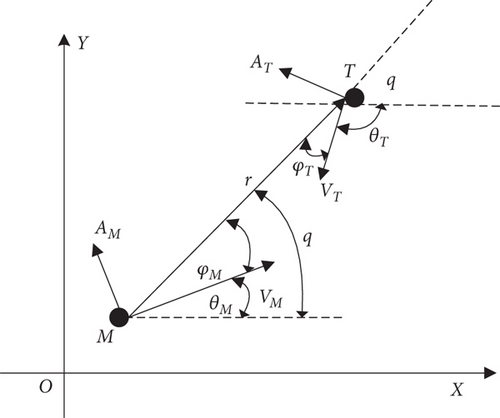
In addition, ballistic straightness is an important factor in describing the performance of the ATT system. Its calculation method is as follows: 10 points are selected along the trajectory, evenly distributed, and the average height of these points is calculated. The ballistic straightness is then obtained by dividing the average height by the distance from the starting point to the endpoint.
2.2. DQN Algorithm
Reinforcement learning algorithms make decisions based on the results of feedback from the environment with the goal of maximizing the reward payoff. Reinforcement learning algorithms are trained to be dynamic, learning autonomously as a result of constant interaction with the environment. The reinforcement learning problem is usually described based on a Markov decision model, which is usually described as a dynamic process F(S, A, P, R, γ) characterized by five parameters, where S is the set of states, A is the set of actions, P is the state transfer function, R is the reward function, and γ is the discount factor.
The Q-learning algorithm is a classical model-free reinforcement learning algorithm. Due to its model-free nature, the subsequent state Snext cannot be obtained directly, generally according to the intelligent body and the environment interaction feedback results, through the form of experiment and sampling to obtain Snext. Based on this, the dynamic process of the Q-learning algorithm is simplified to be described by FQ(S, A, R, γ). The Q-learning algorithm establishes the mapping between discrete states and discrete actions through the Q-table, and the intelligent body obtains the interaction results with the environment after taking the corresponding actions, continuously updates the Q-table based on the comprehensive evaluation of the results, and then makes the goal and behavioral decisions based on the Q-table and the states.
The Q-learning algorithms can only handle low-dimensional data as well as the need to discretize the inputs to the state. However, the state space of real-life practical problems is often very large and continuous. Although the DDPG (deep deterministic policy gradient) algorithm can handle more complex continuous action problems, its network structure is relatively complex, its training time is long, and it may face instability issues when applied to high-dimensional state spaces [32]. Therefore, to ensure the performance of the ATT system, we chose to use the DQN algorithm to design the interception guidance law. The core idea of DQN is to approximate the Q-function using deep neural networks, which is particularly suitable for handling continuous state variables such as the line-of-sight rate in the relative motion model of the ATT and target. By leveraging deep neural networks, DQN effectively addresses complex, continuous state spaces, providing powerful learning capabilities for high-dimensional tasks.
2.3. ATT Autonomous Variable Coefficient Proportional Guidance Law Based on DQN Algorithm
2.3.1. State Space Design
In the guidance process, the line-of-sight angular rate is often chosen as one of the main variables in the guidance law. Therefore, in this paper, the line-of-sight angular rate is chosen as the state space. Considering the variation range of the line-of-sight rate during the ATT interception process and its own overload limitation, the range of the line-of-sight rate is chosen to be [−0.5, 0.5] rad/s. The state inputs of the DQN algorithm can be consecutive, so the line-of-sight rate is inputted directly into the DQN.
2.3.2. Motion Space Design
In the above equation, and are related to the relative state situation, and only the scale factor can be set externally, so the scale factor is used as the action. Since there is a mapping relationship between continuous states and actions in the DQN algorithm, it is necessary to discretize the action space. From the derivation process of the traditional proportional guidance method, it can be seen that usually K takes the value between 2 and 7 and, in this range, is discretized into 51 actions according to the step size of 0.1. Each action represents a proportionality coefficient, and each proportionality coefficient corresponds to each action in the action space. Selecting an action means generating the corresponding proportionality coefficient, and according to the proportionality coefficients, the maneuvering acceleration instruction can be obtained.
2.3.3. Action Selection Strategy Design
In this paper, a greedy strategy is adopted, that is, at the beginning of the algorithm training, a large ε is selected, which makes the intelligent agent search for optimization in a large range. As the learning process continues, the value of ε decreases in order to determine a reasonable action as soon as possible. The pseudocode for the training flow of the ATT variable coefficient proportional guidance law based on the DQN algorithm is shown in Algorithm 1.
-
Algorithm 1: Guide Law Training Process.
-
Deep Q-learning with experience replay.
-
1: Initialize replay memory D to capacity N
-
2: Initialize action-value function Q with random weights θ
-
3: Initialize target action-value function with weights θ− = θ
-
4: For episode = 1, M do
-
5: Initialize sequence s1 = {x1} and preprocessed sequence ϕ1 = ϕ(s1)
-
6: for t = 1, T do
-
7: With probability ε select a random action at
-
8: otherwise select at = argmaxaQ(ϕ(st), a; θ)
-
9: Execute action atin emulator and observe reward rt and image xt+1
-
10: Set st+1 = st, at, xt+1 and preprocess ϕt+1 = ϕ(st+1)
-
11: Store transition (ϕt, at, rt, ϕt+1) in D
-
12: Sample random minibatch of transitions (ϕj, aj, rj, ϕj+1) from D
-
13: Set
-
14: Perform a gradient descent step on with respect to the network parameters θ
-
15: Every C steps reset
-
16: end for
-
17: end for
2.3.4. Reward Function Design
3. Results and Discussion
Firstly, the training situation is set up as follows: the initial position of the target torpedo (0, 0, and 0 m), the initial trajectory inclination angle (30°), the maximum speed of the target torpedo (25, 30, and 35 m/s, respectively), and the maximum angular velocity (40°/s). The initial sailing depth of the target torpedo is selected to be 50 m, and the initial navigation depth of the target torpedo is selected to be 100 m, respectively. The target torpedo adopts the traditional proportional guidance law to attack surface ships.
Surface ships carry ATT; the position of the ship is 0, 2000, and 0 m; and the ship takes a direct motion with a speed of 10 m/s or a maneuvering motion with a speed of 12 m/s and an angular velocity of 1°/s.
The initial position of the ATT is 0, 2000, and 0 m; the initial ballistic inclination of the ATT is selected as three typical values of 0°, 30°, and −30°, respectively; the speed of the ATT is 35 m/s; and the maximum angular velocity is 70°/s. When the surface ship detects the target torpedo, the ATT is launched to intercept the target torpedo.
The initial typical array posture when the ATT intercepts the target torpedo is shown in Figures 2, 3, and 4.
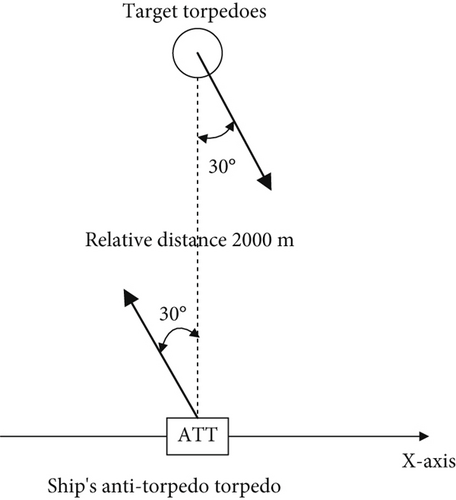
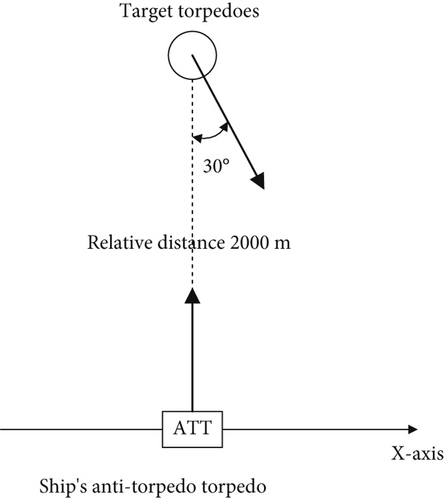
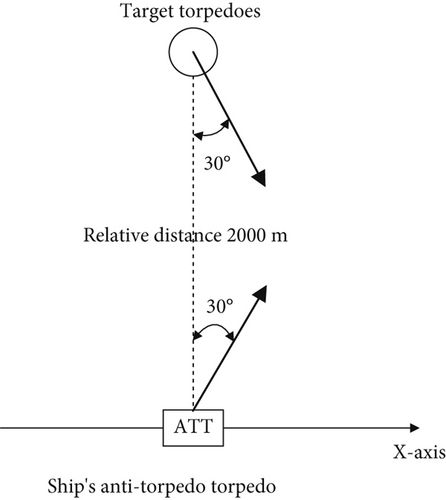
The ATT information is a known quantity, whereas the initial motion information of the incoming target torpedo is an unknown quantity. The depth and speed of the target torpedo are trained randomly; two random values of 50 and 100 m are selected for the depth, and three random values of 25, 30, and 35 m/s are selected for the speed. The surface ship’s maneuvering motion has two types of turning and straight sailing, and there are a total of 36 random initial postures by combining the above random types.
During training, the first randomly extracted posture is used, and after the posture is extracted, 2000 times of learning are performed. In each learning step, ATT receives real-time guidance commands from the DQN algorithm to get the action command. The relative distance of the mine′s eye and the rate of change of the line-of-sight angle are used to generate this command. When the ATT successfully hits the target, or at a certain moment when the value changes from negative to positive, the simulation ends. Then, the system proceeds to the next training simulation.
The DQN algorithm contains many hyperparameters, some of which are highly sensitive to the environment. If the parameters are not set properly, the algorithm may be difficult to converge. Therefore, the hyperparameters need to be constantly adjusted to ensure the convergence of the algorithm during the training of the reinforcement learning task. For the initial environment, we set the following parameters: The learning rate takes the value of 0.001, and the discount rate takes the value of 0.99. The behavioral decision of the ATT is a greedy strategy, which selects the corresponding action in the action space with the parameter ε probability. In the training of the first 400 random postures, ε is assigned to 1, which means that all the actions of ATT come from the action space; in the training of 400~800 random postures, ε is set to 0.1, which means that ATT selects actions randomly with a probability of 0.1 and selects actions according to the current state from the DQN based on the maximum value with a probability of 0.9. This approach takes into account the use of previous experience to obtain a better value with a certain degree of randomness; in 800~1100 random posture trainings, the value of ε is assigned to be 0.05; after 1100 random posture learnings, the value of ε is assigned to be 0, and the ATT selects the action with the maximum Q-value from the DQN according to the current state, until the algorithm converges.
As shown in Figure 5, in the early stages of training, the reward obtained by ATT is small due to less accumulated experience, and the amount of off-target of the guidance law generated in this way is larger. After the training of 200 random postures, richer reward information is accumulated in the DQN; after 400 times of training, the average Q-value becomes larger with the increase of reward obtained by the ATT, which generates the action of each iterative simulation step according to the reward information of the DQN and ultimately makes the algorithm gradually converge, and correspondingly, the ATT can successfully intercept the target and reduce the off-target amount.
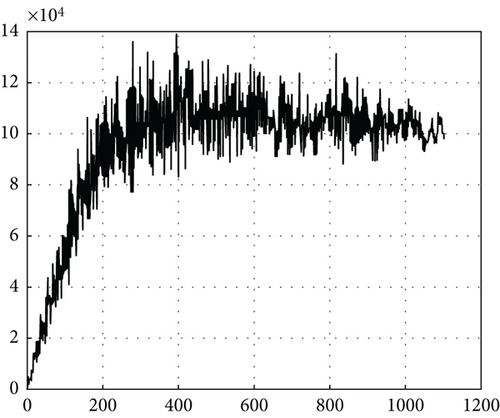
In Figure 6, the blue curve is the ATT intercept trajectory using DQN navigation guidance (DQNNG) after reinforcement learning training, and the red curve is the ATT intercept trajectory using conventional proportional navigation guidance (PNG) under the same simulation conditions.
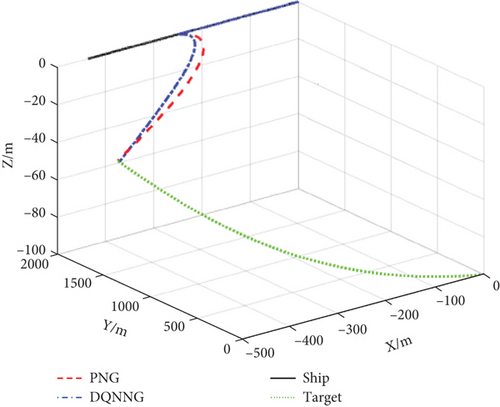
The trajectories of the ATT in the lateral and longitudinal planes, respectively, when the two guidance laws are employed are shown in Figure 7. It can be seen that the DQNNG trajectory is flatter and consumes less maneuvering capability compared to the PNG trajectory. From Figure 8, it can be observed that the line-of-sight angular velocity approaches 0 faster when DQNNG is used and the ATT is aligned to the target with a faster angular velocity. Throughout the interception simulation, the scaling factor K of the PNG is empirically taken to be a fixed value of 4, while the scaling factor K of the DQNNG is a series of varying values, as shown in Figure 9. The variation curve of the guidance command acceleration is shown in Figure 10.
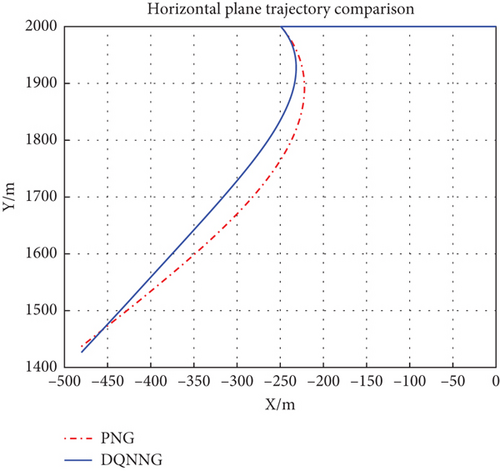
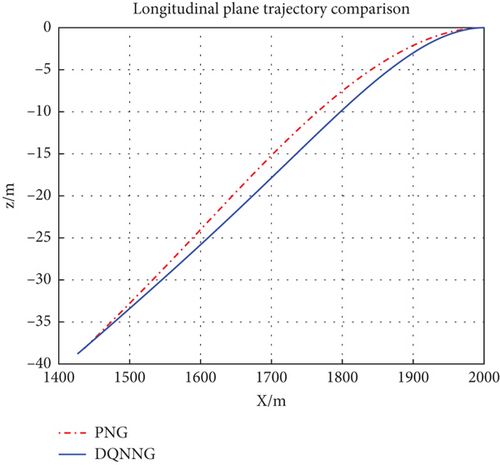
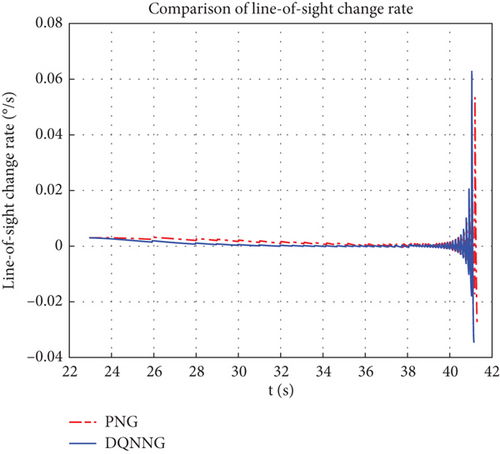
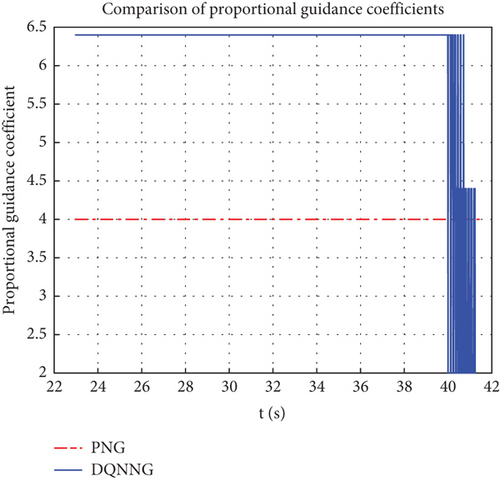
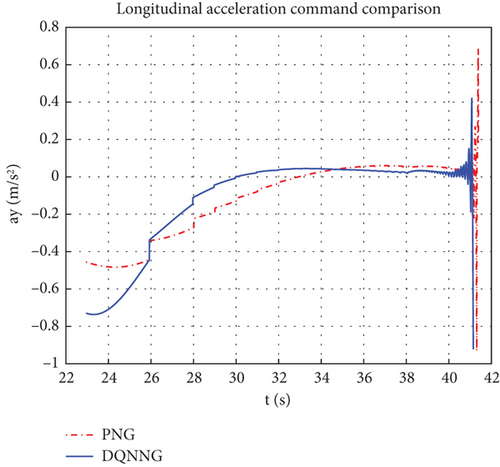
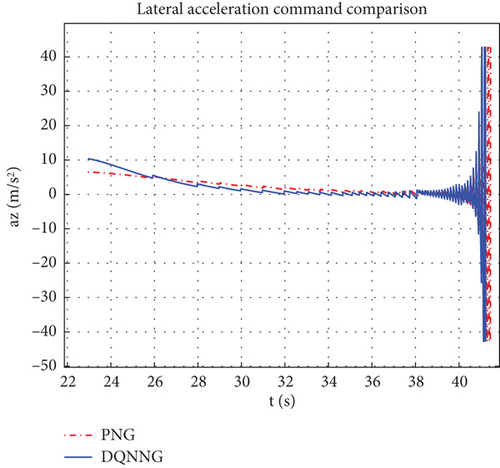
The comparative data of the interception performance between DQNNG and PNG are presented in Table 1. It demonstrates that DQNNG outperforms PNG in several key aspects. DQNNG possesses the capability to make autonomous decisions based on real-time battlefield conditions. By continuously adjusting the scale factor, DQNNG ensures a smaller off-target distance while enabling quicker response to target changes, thereby reducing interception time and improving reaction speed in high-speed and complex environments. Furthermore, the trajectory designed by DQNNG is relatively straight, significantly enhancing the maneuverability of the ATT, reducing overload, and improving guidance accuracy and response speed, while also decreasing maneuvering energy consumption [33]. These advantages are crucial for sustained operational tasks and long-term deployments. As a result, DQNNG demonstrates greater adaptability in complex battlefield scenarios, enhancing overall ATT performance by maintaining high accuracy, minimizing interception time, and reducing resource consumption. This highlights its stronger potential for practical applications.
| Type of guiding law | PNG | DQNNG |
|---|---|---|
| Attack time (s) | 43.49 | 43.25 |
| Total motorized energy (m2) | 6.02 | 5.35 |
| Off-target distance (m) | 0.84 | 0.57 |
| Ballistic straightness (/) | 0.10 | 0.07 |
The traversal simulation of 36 postures using two guidance laws is carried out after the training. The simulation results are shown in Figures 11, 12, and 13. From Figure 11, it can be observed that the amount of off-target is significantly reduced after using the DQNNG guidance law and the off-target distance is reduced by an average of 0.23 m, with an average reduction of 29.08%. The minimum reduction is 0.19 m, while the maximum reduction is 0.27 m.

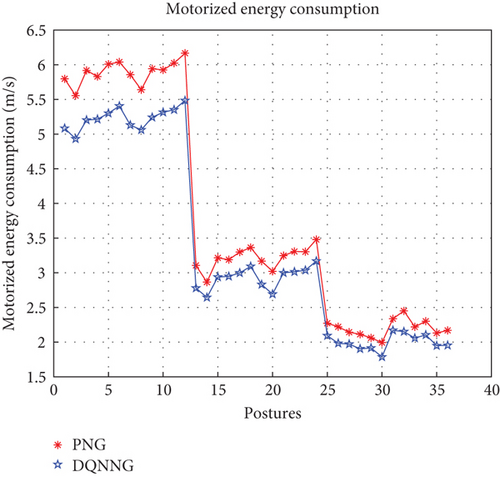
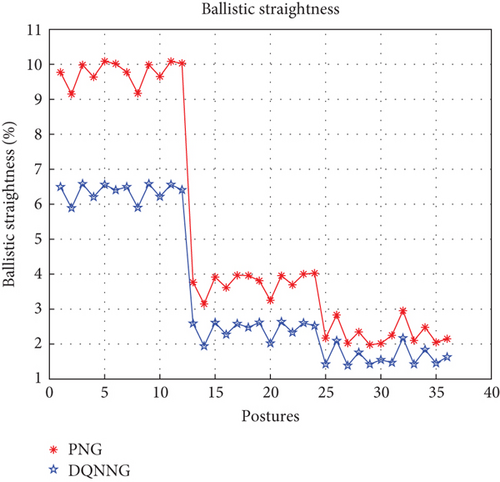
From Figure 12, it can be observed that DQNNG obtains better guidance with less maneuverability consumption than PNG. The average reduction in maneuverability consumption with the DQNNG guidance law is 0.66 m/s, the maximum reduction is 0.73 m/s, and the minimum reduction is 0.58 m/s.
From Figure 13, it can be observed that DQNNG also outperforms PNG in terms of trajectory straightness. This indicates that the earlier attitude adjustment of the ATT makes the rate of change of the line-of-sight angle converge toward zero, which results in a straighter trajectory. The average improvement in straightness after adopting the DQNNG guidance law is 1.8%, the minimum improvement is 0.47%, and the maximum improvement is 3.62%.
To verify the generalization ability of DQNNG in unknown environments, sensor and noise errors as specified in Reference [34] are applied, and 200 Monte Carlo simulations are conducted for both PNG and DQNNG to evaluate their performance and effectiveness. The initial state of the simulation environment is consistent with the training environment, with the initial states of the target torpedo and ATT randomly generated according to the model described earlier.
Figure 14 illustrates the interception trajectories from 200 Monte Carlo simulations, where the blue curve represents the ATT interception trajectory using DQNNG after reinforcement learning training and the green dashed line represents the target’s motion trajectory.
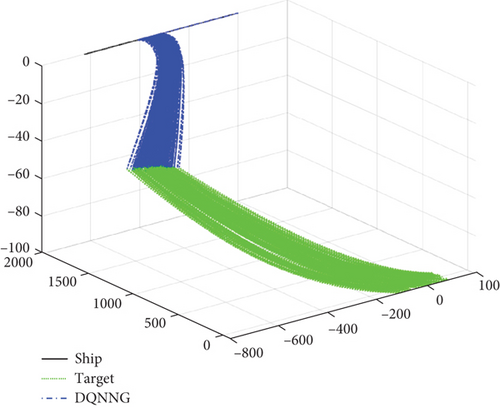
Figure 15 and Table 2 present a comparison of the total motorized energy, off-target distance, and ballistic straightness for PNG and DQNNG over 200 Monte Carlo simulations. The data show that DQNNG performs better in making autonomous decisions by integrating real-time battlefield conditions. By continuously adjusting the scale factor, DQNNG ensures interception accuracy while reducing energy consumption and achieving a flatter ballistic trajectory. Compared to PNG, DQNNG demonstrates superior interception performance. The Monte Carlo test results further confirm that DQNNG has the ability to adapt to unknown disturbance scenarios, highlighting its potential for engineering applications.
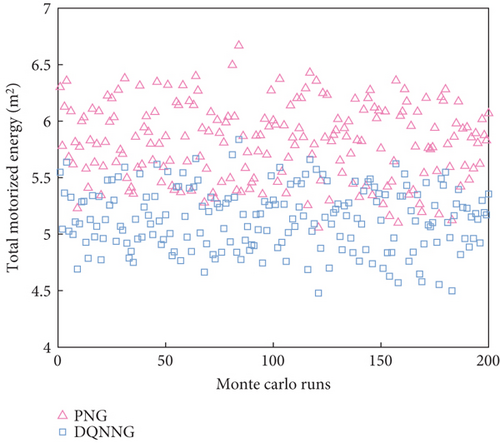
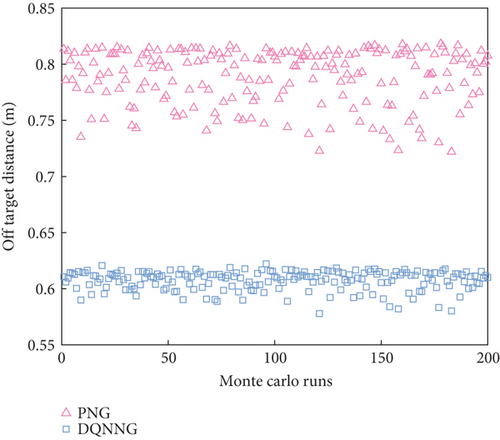
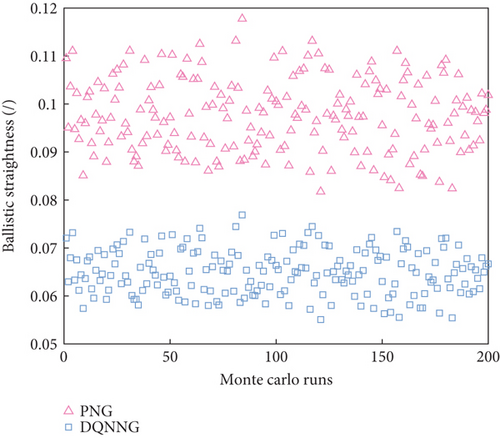
| Type of guiding law | PNG | DQNNG |
|---|---|---|
| Total motorized energy (m2) | 5.82 | 5.13 |
| Off-target distance (m) | 0.79 | 0.60 |
| Ballistic straightness (/) | 0.10 | 0.06 |
| Attack time (s) | 57.91 | 57.58 |
4. Conclusions
This paper presents a reinforcement learning-based ATT variable coefficient proportional guidance law, where the proportional coefficients of the PNG guidance law are actions. The range of proportional guidance coefficients is discretized into an action space consisting of 31 actions. A reward function is designed to guide the reinforcement learning algorithm in updating the DQN to increase the final reward on a hit. After several simulation training sessions, the DQN converges. The DQNNG is compared with the PNG through multistance simulation tests. The results clearly demonstrate that the DQNNG has notable improvements over the PNG in terms of trajectory straightness, maneuver energy loss, and guidance accuracy. The DQNNG proposed in this paper is a guidance law based on continuous state space and discrete maneuver space. To further improve guidance performance, the DDPG algorithm can be subsequently used to transform the maneuver space into a continuous state space and maneuver space guidance law.
In future work, sensitivity analysis of the algorithm’s key parameters will be conducted to assess the impact of different parameter combinations on performance, in order to determine the optimal parameter set and provide an effective range for real-world applications. Adaptive parameter adjustment methods will also be explored to further enhance the algorithm’s performance and adaptability. Regarding practical application, the algorithm will be implemented on hardware platforms, and optimization measures will be investigated to ensure it meets the real-time and accuracy requirements for practical combat scenarios.
Conflicts of Interest
The authors declare no conflicts of interest.
Funding
This work was supported by the Northwestern Polytechnical University Education and Teaching Reform Research Project (2025JGG03).
Open Research
Data Availability Statement
The data that support the findings of this study are available from the corresponding author upon reasonable request.



